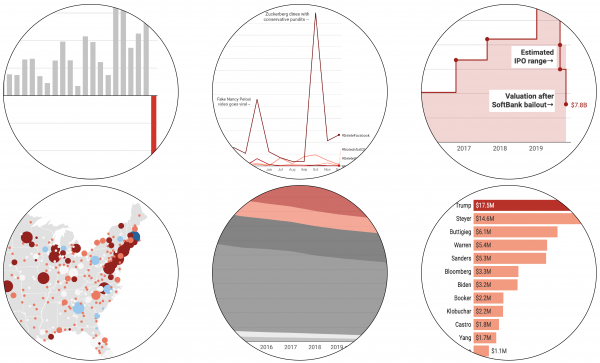
The 14 charts that explain tech in 2019
A year-end look back at the tech trends that ended the decade.
By
Rani Molla@ranimolla
Dec 18, 2019, 12:00pm EST
Share this story
-
Share this on Facebook
-
Share this on Twitter
-
Share
All sharing options
Share
All sharing options for:
The 14 charts that explain tech in 2019
-
Reddit
-
Pocket
-
Flipboard
-
Email
This story is part of a group of stories called

Uncovering and explaining how our digital world is changing — and changing us.
It’s been a year of shattered expectations in tech. Established tech giants are facing a reckoning, as government antitrust investigations and consumer protests jeopardize the status quo. Meanwhile, startup darlings are finding a public market that is no longer as forgiving of tech’s high-growth, low-profit ethos. These changes have accelerated as we approach a new decade — one that’s unlikely to be as kind to tech, both in terms of the stock market and public perception. You might have also noticed that it’s a presidential election year, which brings its own uncertainty for tech companies. From tech jobs to TikTok, here’s a summary of the year in tech in charts.
Highly anticipated tech IPOs have had a rough year
After a long drought of big-name tech IPOs, 2019 seemed like it was going to be a banner year. A crop of highly anticipated, highly valued tech companies — with marquee names like Uber, Lyft, Pinterest, and Slack — all listed on the public markets so that regular people could take a stake. The reception has not been kind. Of the major tech IPOs we’re tracking, only Zoom and Peloton are trading above their first trade price. Of course, the first year on Wall Street can be difficult for companies of all stripes. But the poor stock prices in some ways reflect a change in sentiment toward tech companies, which had long been allowed to focus on growing their businesses rather than bringing in profits. We’re also a decade into a bull market, with threats of a recession on the horizon. As a result, investors are more risk-averse and are placing increased importance on tech companies’ ability to find paths to profitability.
WeWork imploded
Coworking company WeWork had been one of the most anticipated 2019 IPOs, but it never happened. Thanks to a mix of unprofessional behavior from CEO Adam Neumann, poor corporate governance, and unproven financials, the company cancelled its public offering filings and ousted Neumann. That left WeWork in a bind for cash that was quickly running out. The company’s largest investor, SoftBank, bailed it out and ushered in leadership and financial changes. Whether that’s enough to save the company remains to be seen, but it’s unlikely to return to its sky-high $47 billion valuation anytime soon.
SoftBank’s heralded Vision Fund sees losses
WeWork’s spectacular rise and fall was enabled in part by investment from the Vision Fund, whose $100 billion coffers have been upending the investment landscape in Silicon Valley with the sheer size and breadth of investments. But poor performance by WeWork, as well as other unsteady investments like Uber and Wag, have hurt the hand that fed them. SoftBank, the Japanese communications conglomerate behind the Vision Fund, reported its first quarterly operating loss in 14 years last month.
Tech is having its antitrust moment
US tech companies for the most part have long enjoyed freedom from antitrust scrutiny, but 2019 could be the start of a correction. Federal and state lawmakers have opened antitrust investigations into Facebook, Apple, Google, and Amazon, and Democratic presidential candidates like Sen. Elizabeth Warren are laying out plans to break those companies up.
The dominance is real. Facebook and Google control about 60 percent of US online ad revenue. Google rules search. Nearly four in 10 e-commerce dollars spent in the US go to Amazon, and critics say the online giant uses the data it collects from these sales to give its own brands an unfair leg up over competition. Similarly, Apple has been accused of unfairly benefiting its own products in its App Store.
While it’s difficult to track the overall number of tech antitrust investigations, we can surmise from news coverage of the subject that the topic has become increasingly important. Media monitoring firm Meltwater measured 223,000 stories containing both “tech” and “antitrust” globally so far in 2019, up threefold from 2015. While part of the reason for this uptick stems from more content being created — and measured — Meltwater says the rise of stories about antitrust stands out. Similarly, public interest has grown: Digital analytics company Parse.ly saw about three times the viewership of stories about US antitrust law among its network of 3,000 publishers in 2019 than it did in 2018; tech and media companies dominated the topic.
Amazon is breeding more fear in its competition than ever
Speaking of competition, Amazon continues to be a major point of consternation for competitors of all kinds. While many tech companies aim to be the Amazon of X, Amazon’s competitors know that one move by the e-commerce and cloud giant could put them out of business. So far this year, 213 public companies have mentioned Amazon in the “risk factors” section of their annual 10K financial filings, where companies state the most significant risks to their business, according to data from financial data platform Sentieo. Five years ago, that number was just a quarter as high.
Tech activism is on the rise
Tech activism continues to be an important trend this year, both within tech companies and among consumers. Amazon warehouse workers are taking to the streets and online to garner support for unionization. Meanwhile, protesters have attacked Amazon over its cloud contracts that enable companies like Palantir to aid Immigration and Customs Enforcement (ICE). At Microsoft, employees spoke out against the company’s work with the military and oil companies. A year after Google employees walked out to protest the company’s handling of executives’ alleged sexual misconduct, Google’s rank and file are still rallying against their employer for issues as varied as immigration, controversial government contracts, and doing business in China. Meanwhile, Facebook’s role in election meddling, its omnipresence in our personal lives, and CEO Mark Zuckerberg’s perceived coziness with conservative pundits, led some users to make a show of deleting their accounts, causing the hashtag #deleteFacebook to trend. You can get a glimpse of some of this displeasure through trending tech protest hashtags on Twitter this year.
The streaming wars heat up
Netflix has long had a happy lead in the online streaming video space. For years, major TV and movie companies were content to have Netflix pay to license their old content, but eventually they realized they were giving away a valuable resource for far too cheap. Now, pretty much every major media company is launching its own streaming service. Disney+ launched in November. AT&T and Time Warner Cable’s HBO Max, and NBC’s Peacock are coming this spring. And Apple has joined other tech companies like Google and Amazon with its Apple+ streaming option.
Soon, consumers will be presented with a surfeit of streaming options — but their budgets may only tolerate so many subscriptions. That means consumers will soon be forced to draw lines in the streaming sand. Netflix currently leads in subscription streaming usership, with 158.8 million total viewers in the US according to eMarketer (60 million paid memberships), followed by Amazon Video, and Hulu. It’s notable, however, that the nascent Disney+ almost immediately hit 10 million signups after launching and is expected to reach 20 million by the end of the year. So, like the media landscape, expect this ranking to change.
The rise of smart security and fear-based social media
Inexpensive devices and improved cloud computing have ushered in the era of smart devices. Smart security devices — including Google’s Nest and Amazon’s Ring brands — make up the second largest smart-device segment after entertainment, according to shipment data estimates from market intelligence firm IDC. It’s also one of the fastest growing segments. What makes Ring’s devices even more attractive is their social media component: Ring customers can post video to its attendant social media app, Neighbors, to report a theft or suspicious person. This sort of fear-based social media feeds into the trend of people being increasingly worried about crime, even as statistics show that crime is at its lowest rate in decades. The whole system looks for now like a double win for Amazon, which in addition to selling loads of Ring devices also gets to protect its e-commerce business from package theft.
Time well spent wasn’t
Time Well Spent is a movement that sprung up in reaction to people’s seemingly unhealthy addiction to their digital devices. It spurred widespread introspection about tech use and concerns about whether smartphones were responsible for a whole host of societal and health problems. In its wake, myriad firms sprung up to help people regulate their technology use. Even the very tech companies that profited off our addiction started arming consumers with ways to spend less time with those devices. And yet, as a whole, the amount of time we spend with tech is still growing.
The average US user in 2019 spends about four hours each day with online media, according to data from measurement company Zenith, a stat that continues to tick up thanks completely to growing mobile phone usage. If the movement has been effective, its results might be restricted to wealthier people and those responsible for creating such tech in the first place. Another study notes that poor kids spend nearly two hours per day more on screens than their wealthier counterparts.
Data privacy is giving consumers plenty to worry about
Again and again, tech companies have failed to safely steward user data. At the same time they are also collecting increasing amounts of it. With limited legal frameworks surrounding data privacy and with technology being increasingly central to people’s lives, the situation feels sort of hopeless. According to a recent Pew Research Center study, most Americans don’t think it’s possible to control the data companies and the government collect. That said, a majority also feel that the collection of this data isn’t in their best interests.
All eyes are on digital platforms for 2020
Ahead of a presidential election year, all eyes are on technology and social media platforms, whose effects on the 2016 election still are not fully understood. Digital political ad spending is expected to hit about $3 billion next year or about one-third of overall campaign ad spending. Some tech platforms have sought to mitigate election interference and misinformation through an outright ban on political ads (Twitter) or by limiting candidates’ ability to microtarget voters (Google). Facebook, however, the largest platform for digital campaign ad spending, has failed to make significant changes. Facebook has even stood by its controversial stance of not touching political ads, even if they contain lies. It remains to be seen how these choices will affect the next election.
Tech’s importance grew as a part of the larger US economy
Internet technology companies make up the biggest share of the S&P 500, a market capitalization-based measure of the health of the country’s biggest companies and the US economy at large. That’s impressive given that, last year, the index’s governing body moved companies like Facebook, Twitter, Netflix, and Google out of “Internet Technology” and into the newly named “Communications Services” sector, which also houses companies like Verizon and AT&T. Together, those two sectors now make up more than one-third of the index.
Tech job growth is concentrated in few cities
While tech is making some people very, very wealthy, its impact on jobs — and by extension the economy — has been concentrated in just a handful of mostly coastal US cities. A full 90 percent of growth in high-tech jobs since 2005 occurred in just five US metro areas — Boston, the San Francisco Bay Area, San Jose, Seattle, and San Diego — according to a new report from The Brookings Institution and the Information Technology and Innovation Foundation. Tech, more than other industries, relies on the magnet of existing tech infrastructure, companies, and highly-skilled employees, meaning that cities like San Francisco keep attracting more tech companies. As a result, lots of other potential US tech hubs are finding themselves left out of the boom, and the prosperity it brings with it.

TikTok took social media by storm
While usership of other popular social media like Facebook, Twitter, and Snapchat has plateaued, TikTok’s popularity took off. While TikTok doesn’t disclose user numbers, we know that its parent company ByteDance has more than 1 billion monthly active users across its apps. A leaked pitch deck says it has more 30 million US users, each of whom spend 46 minutes each day on the app, on average. Its monthly unique downloads were more than 70 million in November, about five million higher than a year ago, according to data from app measurement company Sensor Tower. That puts it ahead of downloads for app store staples Facebook, Messenger, and Instagram. More importantly, it’s become a cultural sensation and a unique form of expression, especially among young people.
Sourse: vox.com






